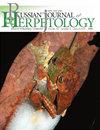欧洲池龟(Emys orbicularis,林奈,1758)在巴巴特山谷(Gödöllõ,匈牙利)的产卵地点选择和使用策略
IF 0.9
4区 生物学
Q3 ZOOLOGY
引用次数: 0
摘要
在阳光下晒太阳是淡水龟(如欧洲塘龟)保持最佳体温的最常用方法。大生境和微生境特征的属性影响着欧洲塘龟的晒地选择。为了保护欧洲塘龟,在了解其生物特征的基础上,了解它们的晒太阳习惯,以及栖息地特征对其的影响和选择日光浴地点的类型是很重要的。本研究的目的是探讨大生境和微生境特征对晒地选择的影响。我们想要根据甲壳长度类别来确定晒地类型的选择,以及不同厚度的晒树干和树枝的选择是否有差异。海龟选择在环境中较少封闭植被的地方晒太阳。我们发现了微生境特征的季节性差异。芦苇和台风的关闭对观察到的海龟数量有负面影响。池塘系统中最受欢迎的日光浴地点类型是水中经常出现的倒下的树干和树枝,无论海龟的体型大小。大多数海龟使用较细的树干和树枝来晒太阳。与此同时,我们发现不同体型的海龟在选择晒树干方面存在差异。体型较小的年轻海龟在直径较小的树枝上出现的数量较多。本文章由计算机程序翻译,如有差异,请以英文原文为准。
Basking Site Selection and Usage Strategies of the European Pond Turtle, Emys orbicularis (Linnaeus, 1758) in Babat valley (Gödöllő, Hungary)
Sun basking is the most common method for freshwater turtles, such as the European pond turtle, to maintain optimal body temperature. The attributes of the macro- and microhabitat features around the basking sites affect the basking site selection of the European pond turtle. To protect the European pond turtle, it is important to know the basking habits among the biological characteristics of the species, along with the effects of the habitat characteristics and the choice of the type of basking sites. The purpose of our research was to detect the effects of macro- and microhabitat features on the selection of basking sites. We wanted to determine basking site type selection according to the carapace length classes and if there is any difference in the choice of basking trunks and branches with different thicknesses. Turtles choose basking sites with less closed vegetation in their environment. We have detected seasonal differences in the microhabitat features. The closing reed and Typha sp. had a negative effect on the number of observed basking turtles. The most popular type of basking sites in the pond system was the commonly occurred fallen tree trunks and branches in the water, regardless of turtle body size. Most turtles used thinner tree trunks and branches for basking. In the meantime, we found differences in the choice of basking trunks between the turtles with different body sizes. Younger turtles with smaller bodies appeared in larger numbers on emergent branches with smaller diameters.
求助全文
通过发布文献求助,成功后即可免费获取论文全文。
去求助
来源期刊

Russian Journal of Herpetology
ZOOLOGY-
CiteScore
1.70
自引率
0.00%
发文量
29
期刊介绍:
Russian Journal of Herpetology is an international multi-disciplinary journal devoted to herpetology. Russian Journal of Herpetology accepts original papers on ecology, behavior, conservation, systematics, evolutionary morphology, paleontology, physiology, cytology and genetics of amphibians and reptiles.
Types of Contributions:
-original papers
-invited or contributed reviews on specific topics
-short communications on topics of immediate interest, new methods and ideas in progress
-notices of meetings, symposia, and short courses
-book reviews
 求助内容:
求助内容: 应助结果提醒方式:
应助结果提醒方式:


